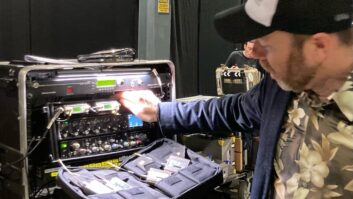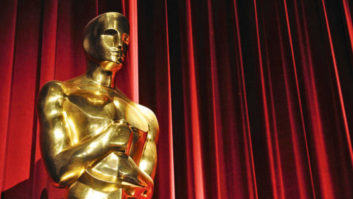
Warsaw, PL (June 4, 2024) — The Zone of Interest examines the Holocaust not via human horrors or war-room drama, but through the day-to-day lives of Auschwitz commandant Rudolf Höss (Christian Friedel) and his family. Ordinary and even mundane activities transpire in a manicured residence within sight of the camp’s chimneys, echoing Holocaust survivor Hannah Arendt’s historic comment on the banality of evil. This profoundly chilling juxtaposition propelled the film to a 2024 Academy Award win for Best Sound and Best International Film, and a U.K. Oscar for Best International Feature. Director Jonathan Glazer insisted on an immersive set in which the actors scarcely knew they were in a movie. This presented mixing lead Tarn Willers and his department with unprecedented challenges; rising to them led to Best Sound wins from both the Academy and BAFTA. In this conversation, Willers describes the role Lectrosonics wireless played in crucial aspects of the workflow. His kit comprised SMB, SMDB, and HMa transmitters as well as SRb receivers mounted in an Octopack multi-coupler.
“Jonathan Glazer wanted the actors to exist entirely inside a world, with no evidence of film paraphernalia in sight,” explains Willers. “We had ten cameras hidden in the main house. The actors improvised a great deal. They didn’t have marks. I had to get great range and clarity on two floors, through thick concrete walls, and across the outdoor garden. The house was live, with no one except the actors allowed in during shooting. So, no boom operators. We could not have RF or dropout issues, period, because we couldn’t just run in and check things. Much of the time, the actors didn’t know where the cameras were. Sound from every source had to be flawless, all the time.”
To achieve this, Willers and re-recording mixer Johnnie Burn depended heavily on wireless. “We had radio mics on the actors, plus several plant mics placed strategically throughout the house and garden. I used SMB and SMDB transmitters. I also had HMa transmitters for the plant mics. My SRb receivers are mounted in an Octopack. Just over the garden wall was a container dressed to look like a guard shack. Inside that shack were me with my receivers, Jonathan with his monitors, and the video playback.”
Within this matrix of microphones, actors would sometimes do long walk-and-talks. “For example,” says Willers, “from the bedroom down the stairs, through the kitchen and out into the garden.” When asked if he consistently received clear audio free of dropouts or interference, Willers’ answer was simple: “Yes, the setup worked. It had to.”
Though much of the film’s scenes involved interiors, but a scene involving a family canoe excursion tested Lectrosonics’ reputation for durability under adverse conditions. “We shot that scene on a scorching hot day, as was scripted. It was also scripted that a storm would hit and made them return home,” he recalls. “Lo and behold, an actual monsoon-like rain occurred, so I suppose creatively speaking, the weather gods were with us! The kids and Christian were just wearing vests, and I had been directed that at any point, one or more of them might jump into the river to push the canoe. So, no body packs were used.”
Instead, Willers placed his SMBs closer to water than any lesser mixer would dare tell a rental house about. “Around the inside rim of the canoe, there’s a lip just wide enough to hide assets. I planted five mics on SMB transmitters. Aqua-packs would’ve been seen, so I wrapped them in cling film. Even though a little bit of water got through, the transmitters performed all the way through the sequence with no issues whatsoever. Some of the mics were casualties of war, but the transmitters lived.”
For director Glazer, and the entire cast, sound, and post teams, the ultimate proof of Willers’ and Lectrosonics’ wireless mettle was the near absence of any automatic dialogue replacement (ADR) in the entire film. “No ADR was needed for audio or technical reasons,” he says. “There might have been a couple of lines added creatively, but that was it. What you hear in the cinema is the actors speaking on set.”
About Lectrosonics
Well-respected within the film, broadcast, and theatre technical communities since 1971, Lectrosonics wireless microphone systems and audio processing products are used daily in mission-critical applications by audio engineers familiar with the company’s dedication to quality, customer service, and innovation. Lectrosonics received an Academy Scientific and Technical Award for its Digital Hybrid Wireless® technology and is a US manufacturer based in Rio Rancho, New Mexico. Visit the company online at www.lectrosonics.com.







